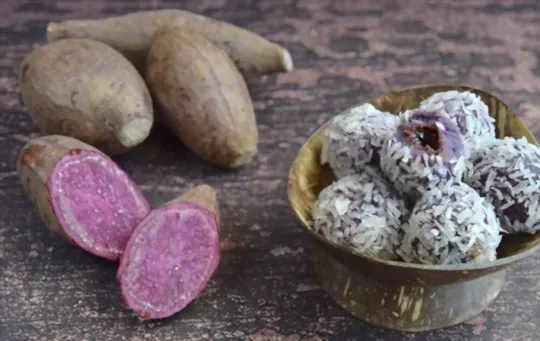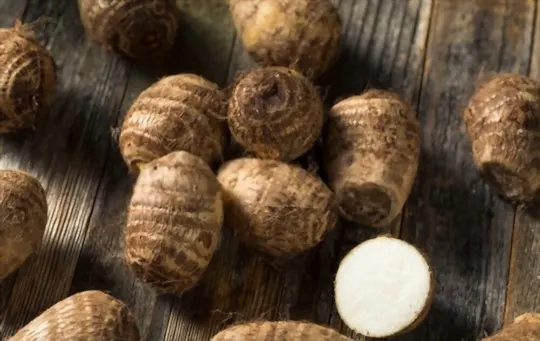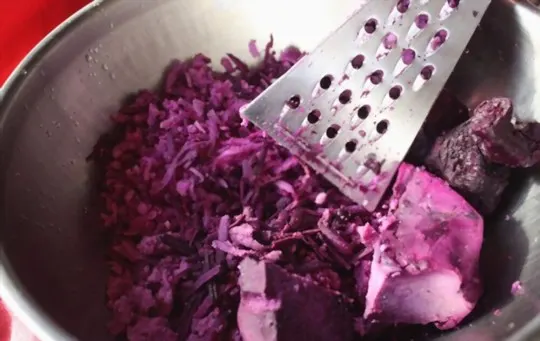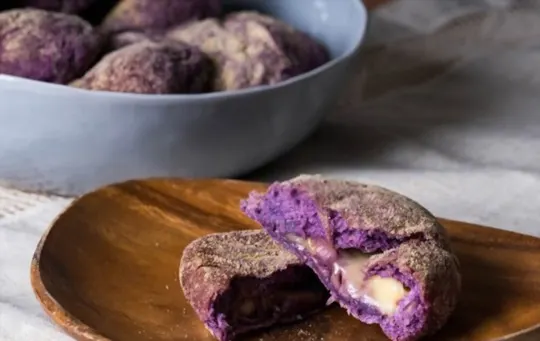Summary of key points
Ube and taro are distinct in their appearance, taste, and culinary uses. Ube, or purple yam, is notable for its vibrant purple color and sweet, nutty flavor, making it popular in desserts and sweet concoctions. Taro, on the other hand, has a brown, hairy exterior with a white, lavender, or pink flesh and offers a starchy, slightly sweet taste. It is used in a wider range of dishes, including both savory meals and sweets. The unique characteristics of ube and taro contribute to their diverse applications in cooking and baking.
One of the most interesting debates in the food world is that of ube vs taro.
Both are root vegetables with a long history and cultural significance, but they have different nutritional properties and distinct flavors that can be used to create amazing dishes.
People have been asking which one is better for years, and it’s time to put this debate to rest.
In this article, we’ll compare and contrast ube and taro, explain the differences between them, discuss their similarities, and help you decide which one to choose.

What is Ube?

Ube, scientifically known as Dioscorea alata, is a type of purple yam that is widely used in many Asian cuisines.
It originates from the tropical regions of Asia and grows primarily in Southeast and East Asian countries like Taiwan, China, Japan, the Philippines, Thailand, and Indonesia.
Ube has been cultivated for centuries and is now becoming increasingly popular all over the world.
Ube contains essential minerals like manganese, which helps to reduce inflammation and protect against oxidative stress; Vitamin C, which aids in immune system functioning; calcium which helps build strong bones; plus dietary fiber, to help improve digestion.
Ube also provides B vitamins, including thiamin (vitamin B1), riboflavin (vitamin B2), and niacin (vitamin B3), which help the body produce energy from carbohydrates.
It is also a great source of potassium, magnesium, phosphorus, and iron.
Ube has been widely used in many culinary applications for centuries.
In the Philippines, it is commonly made into desserts like halo-halo, ube jam, and ube halaya.
In Japan, it is often enjoyed as an ice cream topping or incorporated into tarts and pastries.
Ube can also be boiled or steamed to make delicious side dishes or added to soups such as miso soup.
Other popular regional dishes include ube cake, ube bread pudding, and ube pancakes.
Although Ube has a purple hue, it is actually quite different from other foods with similar colors.
For example, Ube has a unique starchy and sweet flavor that can’t be found in other purple-colored fruits or vegetables.
It also has a distinctive texture when cooked, which makes it perfect for creating delicious dishes.
Despite its growing popularity, there are still some common misconceptions about Ube.
Some people mistakenly believe that Ube is actually the same as taro root or lavender flower buds.
However, these ingredients have vastly different flavors and textures than Ube, which makes them unsuitable for many of the uses that ube is well-suited for.
What is Taro?

There are many exciting things to know about taro, a root vegetable that has been grown and consumed for centuries.
The taro plant is an ancient tropical crop believed to have originated in Southeast Asia or the Indian subcontinent.
Commonly referred to as elephant ears due to their large, heart-shaped leaves, it is also known as the dasheen, eddoe, and kalo, depending on the region where it is cultivated.
It is packed with nutritional value and health benefits that make it a wise choice for inclusion in your diet.
It contains essential vitamins such as A, C, E, K, and B6; minerals like potassium and magnesium; dietary fiber; and antioxidants that help protect cells from damage.
Additionally, it is low in fat and contains no cholesterol.
Taro can be used in a variety of ways, both sweet and savory, making it perfect for adding to dishes or using it as a side dish in its own right.
Popular dishes made with taro include poi, which is a Hawaiian specialty made from mashed taro root; taro chips; soups like Chinese-style taro soup; baked goods such as French tartiflette; and even desserts like a steamed pudding.
Taro is not the same as other root vegetables such as potatoes, sweet potatoes, and yams.
It has a distinct flavor that can be described as nutty and earthy with a faint sweetness to it.
Additionally, taro contains high levels of oxalic acid, which means it must be cooked before you consume it; otherwise, it can cause irritation to your throat and digestive system.
The Differences Between Ube and Taro
Ube and taro are two different root vegetables that often get confused with one another due to their similar shapes, colors, and usage in various dishes.
While they do share some similarities, there are distinct differences between ube and taro that make them unique ingredients with their own set of flavors and uses in cooking.
When it comes to physical appearance, both ube and taro have thick skin that ranges from light purple to dark brown in color.
Ube is usually rounder than taro, while the latter has more of an oval shape.
Underneath their skins, however, lies the main difference between these two tubers; ube is bright purple inside, whereas taro is white or cream-colored with a hint of pink.
When it comes to taste and texture, ube has a more earthy flavor with a starchy, nutty profile, while taro has a milder, slightly sweet taste that can be compared to potato.
Ube is also creamier than taro, which has a drier consistency when cooked.
Nutritionally speaking, both ube and taro are high in fiber and low in fat and offer some of the same benefits, including improved digestion as well as being rich in antioxidants.
Ube is higher in calcium and iron than taro, however, so if you’re looking for an extra boost of these two minerals, then ube is the healthier choice.
In terms of their culinary uses, ube is more commonly found in desserts such as ice cream, cakes, and pastries due to its sweet flavor.
Taro, on the other hand, is primarily used in savory dishes like soups and stews or even fried for a tasty snack.
Many cultures have their own traditional recipes that incorporate one or both of these ingredients, so it’s worth exploring different cuisines to discover all the delicious possibilities these two vegetables can offer.
Ube and taro are also quite different when it comes to cultivation and availability.
Ube grows best in warmer climates, although you can find it year-round in some stores, while taro roots are generally much smaller than those of ube and require cooler temperatures that can only be found in certain regions.
It is also more difficult to find taro compared to ube.
In recent years, both of these ingredients have been incorporated into modern recipes and fusion cuisine to create unique dishes with a hint of their traditional flavors.
Ube has become increasingly popular due to its sweet flavor and vibrant color, making it a favorite for cakes, drinks, pastries, and desserts, while taro continues to be used as the main star in many savory dishes from around the world.
Similarities between Ube and Taro

While Ube and Taro may look very different, they share some similarities.
Both are rooted in Asian cultures and have been around for many centuries.
While often a staple of savory dishes, both Ube and Taro can be used to create delicious desserts as well.
In terms of health benefits, Ube and Taro contain many vitamins and minerals that help promote strong bones and overall good health.
These include Vitamin C, Potassium, Calcium, Iron, Magnesium, Zinc, Phosphorous, Copper, Manganese, and Vitamin B6.
They also provide dietary fiber, which helps digestion and is essential for weight loss programs.
Both Ube and Taro are considered quite versatile when it comes to cooking.
They can be boiled, steamed, fried, or even baked.
They can also be used in soups, stews, and stir-fries.
Ube is particularly popular in Filipino cuisine, while taro is often used in Chinese and Japanese fare.
Ube and taro also make great ingredients for sweet dishes like cakes, puddings, and ice cream.
The unique flavors of each tuber are complimented by added sugar which makes them a great addition to many recipes.
Both can also easily be turned into flour to create gluten-free cakes, muffins, and other desserts.
Conclusion
Ube and taro are both starchy root vegetables that have a similar appearance and texture.
Both ube and taro can be used in sweet or savory dishes, but they have some key differences.
For one, ube is slightly sweeter than taro.
Additionally, ube has a brighter purple color, while taro is more subdued.
While you may not be able to taste the difference between these two ingredients, understanding the key distinctions will help you cook with them more confidently.
Do you have a favorite recipe that uses either ube or taro? Share it with us in the comments below.

Ube vs Taro – What’s the Difference?
Ingredients
- Ube
- Taro
Instructions
- Choose between two items based on your preference and availability.
- Follow the cooking directions for your chosen option, using the appropriate ratio of ingredients.
- Prepare it according to your desired recipes.
- Incorporate them into your dish, adjusting the amount to suit your taste.
- Enjoy the unique taste experience and experiment with different dishes to explore their versatility.

Andrew Gray is a seasoned food writer and blogger with a wealth of experience in the restaurant and catering industries. With a passion for all things delicious, Andrew has honed his culinary expertise through his work as a personal chef and caterer.
His love for food led him to venture into food writing, where he has contributed to various online publications, sharing his knowledge and insights on the culinary world. As the proud owner of AmericasRestaurant.com, Andrew covers a wide range of topics, including recipes, restaurant reviews, product recommendations, and culinary tips.
Through his website, he aims to inspire and educate fellow food enthusiasts, offering a comprehensive resource for all things food-related.

Leave a comment